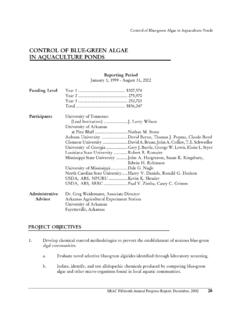Transcription of MANAGEMENT OF ENVIRONMENTALLY-DERIVED …
1 SRAC Fourteenth Annual Progress Report, December, 2001 20 MANAGEMENT of environmentally -DerivedOff-flavors in Warmwater fish PondsReporting PeriodJune 1, 1996 - August 31, 2001 Funding LevelYear 1 .. $250,827 Year 2 .. 250,142 Year 3 .. 229,266 Year 4 .. 80,900 Year 5 .. 56,100 Total .. $867,235 ParticipantsUniversity of Tennessee, Lead Institution ..Thomas K. HillUniversity of Arkansas at Pine Bluff ..Peter W. PerschbacherAuburn University ..Claude E. BoydAuburn University ..R. Thomas LovellLouisiana State University ..Leslie C. PlhakLouisiana Tech University ..H. Lynn WalkerUniversity of Memphis ..King-Thom ChungUniversity of K. SchlenkMississippi State University ..David J. WiseTexas A & M M. GatlinAdministrativeDr. Don O. Richardson, Dean (Retired) AdvisorAgricultural Experiment StationUniversity of TennesseeKnoxville, TennesseePROJECT the feasibility of decreasing the incidence of fish off-flavors by reducing the amountof phosphorus available to support phytoplankton methods of reducing phosphorus input by diet modification by deter-mining the minimum phosphorus requirement for food-sized channel catfish andquantifying the reduction in waste phosphorus generation by food-sized catfish fed"low-phosphorus" feeds relative to presently available OF environmentally -DERIVEDOFF-FLAVORS IN WARMWATER fish PONDSSRAC Fourteenth Annual Progress Report, December.
2 2001 21 MANAGEMENT of environmentally -DerivedOff-flavors in Warmwater fish methods of removing phosphorus from pond waters by studying methodsof enhancing rates of phosphorus removal from pond waters by pond bottom soilsand determining the feasibility of precipitating phosphorus from pond waters assparingly soluble aluminum or calcium the feasibility of reducing the incidence of fish off-flavors by manipulating pondphytoplankton biomass and taxonomic composition using biological and chemical the effect of filter-feeding fishes on water quality and reduction orelimination of off- flavor in pond-raised channel microbial pathogens to control blue-green algal whether plant phenolics (tannins) can control growth of microorganismsthat produce odorous compounds in warmwater fish the effect of routine, low-level treatments of ponds with copper sulfate onphytoplankton communities, off- flavor incidence, and water quality in channel the feasibility of managing fish off-flavors by reducing rates of 2-methylisoborneol(MIB) uptake by fish and/or enhancing rates of MIB elimination from statistical models describing the within-pond variation in the degree of off- flavor infish populations under various analytical techniques for assessing flavor qualities in publications to educate producers and processors on the ecology ofenvironmentally- derived off-flavors, off- flavor MANAGEMENT , and the results of this BENEFITSThe overall goal of this project is to reduce theincidence of unacceptable flavor quality in pond-cultured fish .
3 If this goal is accomplished, theaquaculture industry will benefit from increasedfarm profits and market expansion resulting fromimproved consumer attitude toward of the revised phosphorus allowance incommercial catfish feeds should reduce thephosphorus input to catfish ponds and thusreduce nutrients available to support algaegrowth. Similarly, use of alternative phosphorussupplements or phytase enzymes to increaseutilization of phytate phosphorus in the feedmay be beneficial in reducing phytoplanktongrowth and thus reduce occurrence of of the impact on algal communities,these studies will lead to more efficient use ofphosphorus from Fourteenth Annual Progress Report, December, 2001 22 PROGRESS AND PRINCIPAL ACCOMPLISHMENTSO bjective 1A. Evaluate methods of reducing phosphorus input by dietmodification by determining the minimum phosphorus requirement forfood-sized channel catfish and quantifying the reduction in waste phosphorusgeneration by food-sized catfish fed low-phosphorus feeds relative topresently available of environmentally -DerivedOff-flavors in Warmwater fish PondsThe use of chemical substances for reducing phos-phorus levels in pond water could provide asimple procedure for channel catfish farmers andother aquaculturists to use in reducing the amountof phosphorus in waters of ponds to which largeamounts of feed are applied.
4 The benefits of thecompounds (aluminum sulfate, calcium oxide,and calcium sulfate) chosen for use in this re-search are that they are common compounds,they are relatively inexpensive, they are environ-mentally safe and would not pose a food safetyrisk, and they would be easy to apply. If one ormore of these compounds can reduce phyto-plankton blooms, and especially blooms ofblue-green algae, there does not appear to be anyreason that farmers would not accept them two biological control measures under in-vestigation (use of filter-feeding animals and useof natural algal pathogens) are particularlyattractive because they avoid the use of chemicalcontrol measures. In the case of control mea-sures using filter-feeding fish or clams, economicreturns from harvest of the animals stocked foralgae control may be an added benefit. Otherimprovements in water quality may also example, a state fish hatchery is participat-ing in the large-scale evaluation of planktivorousfish with the hopes of addressing chronic prob-lems with low dissolved oxygen chemical control measures are beinginvestigated, including the use of copper sulfateand natural compounds such as plant studies should also lead to the developmentof one or more novel chemical treatments thatcan be used to control noxious studies focus on enhancing the elimi-nation of MIB from channel catfish, so thatoff- flavor fish may be purged more effectivelyprior to processing.
5 These approaches may beof significant economic value to the aquaculturalindustry. Also, improved methods of analysisfor geosmin and MIB that are comparable orbetter than sensory methods with regards to sen-sitivity, and comparable or better than GCanalysis in terms of objectivity will be methods have these benefits andcan also be formatted into rapid and simple testkits for industry. These methods will providethe industry with a better tool for quality con-trol and fish grading as well as the researchcommunity with a better tool to study off-flavordevelopment and minimum dietary available phosphorus re-quirement for food-size channel catfish fedcommercial type diets was determined in a 7-month pond study. The available phosphorusrequirement based on subclinical measure-ments (bone breaking strength and alkalinephosphatase activity) was found to be ofthe diet, although the requirement for maximumgrowth was less than this. These data indicatethat the available phosphorus requirement forcommercial catfish feeds should be of thediet, which is approximately 25% lower than theSRAC Fourteenth Annual Progress Report, December, 2001 23 MANAGEMENT of environmentally -DerivedOff-flavors in Warmwater fish Pondspresent National Research Council availability of different forms of phospho-rus in practical feed ingredients was determinedfor channel catfish.
6 A reference diet and testdiets containing either menhaden fish meal, fishmeal analog, meat and bone meal, soybean meal,cottonseed meal, corn, rice bran, wheat, andwheat middlings were fed to channel catfishafter which fecal samples were collected andanalyzed to determine the availability of differ-ent forms of phosphorus from the various feed ingredients varied considerablyin terms of their phosphorus composition andavailability to the fish . Wheat, sorghum, andcottonseed meal had the greatest phosphorusavailability of the plant feedstuffs while fish mealanalog had the greatest availability of the ani-mal feedstuffs. Also in this study, the uptakeand mineralization of different forms of phos-phorus and nitrogen in feces from channel catfishfed the various ingredients were trials were also conducted withchannel catfish to evaluate several differentfeedstuffs which have been genetically modifiedto contain low concentrations of phytic phytic acid which is typically found in rea-sonably high concentrations in plant feedstuffsis indigestible and thus excreted by fish .
7 Thelow-phytate varieties of barley, corn, and soy-bean meal which have been evaluated haveelevated phosphorus availability to channel cat- fish . Thus, as these feedstuffs become morereadily available, they may provide a dietarymeans of reducing phosphorus excretion by study was conducted to evaluate dietformulations and feeding strategies to marginallymeet the phosphorus requirement of channelcatfish while minimizing dietary phosphorusinput. Fingerling channel catfish were fed oneof three practical diets with either no phosphorussupplementation (approximately availablephosphorus), minimal phosphorus supple-mentation from dicalcium phosphate ( phosphorus), or standard phosphorussupplementation from dicalcium phosphate( available phosphorus) for 8 weeks inaquaria. Two additional treatments includedfeeding the diet containing availablephosphorus with intermittent feeding (two daysevery other week or every fourth week) of thediet containing available of pectoral spines and whole-bodytissues indicated adequate phosphorus status ofchannel catfish could be maintained with minimalphosphorus input by feeding the unsup-plemented diet in conjunction with thephosphorus-supplemented diet for two daysevery fourth pond study was conducted to quantify thereduction in waste phosphorus generation byfood-size channel catfish fed experimental dietsformulated to contain 28% protein and phosphorus from either dicalcium phos-phate (water-soluble) or defluorinated phosphate(water-insoluble) phosphate.
8 No statistical dif-ferences were observed in weight gain, feedconversion, survival, bone ash, and bone phos-phorus between fish fed the two diets. Therewere no significant differences in total phospho-rus, soluble phosphorus, and chlorophyll a Low-phytate varieties of barley, cornand soybean meal elevate phosphorusavailability to channel catfish so theymay provide a dietary means ofreducing phosphorus excretion asthese feed stuffs become more at a Fourteenth Annual Progress Report, December, 2001 24 Objective 1B. Evaluate methods of removing phosphorus from pondwaters by studying methods of enhancing rates of phosphorus removalfrom pond waters by pond bottom soils and determining the feasibilityof precipitating phosphorus from pond waters as sparingly solublealuminum or calcium of environmentally -DerivedOff-flavors in Warmwater fish PondsIn 1996, laboratory and pond studies wereconducted to determine the feasibility ofprecipitating phosphorus from waters assparingly soluble aluminum or calcium saltsthrough the application of aluminum sulfate(alum), calcium oxide (lime), or calcium sulfate(gypsum).
9 The gypsum application had thegreatest effect, and the treatment was repeatedin 1997 at a higher application rate. At thehigher rate (increasing total hardness to 200 ppm),gypsum significantly reduced total phosphorusand chlorophyll a levels. More frequentapplications of alum to pond water (1998) showeddistinct short-term effects but little long-termchange in the pond water quality. Repeatedapplications of 7 pounds/acre of agriculturallimestone at 2-day intervals also reduced solublephosphorus concentrations but had little effecton phytoplankton. A 120-day pond trial wascompleted which evaluated the effects of periodicadditions of alum on the availability ofphosphorus in the pond environment. Additionof alum at 50 ppm every other week did notaffect total production or feed conversion ofchannel catfish in ponds. In addition,waterborne phosphorus concentration, primaryconcentrations in pond water between the twodietary pond study was conducted in Mississippi toquantify the reduction in waste phosphorus gen-eration by food-sized channel catfish fed lowphosphorus diets.
10 A basel diet was formulatedto contain 32% protein without supplementalphosphorus ( available phosphorus).Supplemental phosphorus was added to the basaldiet to provide available phosphorus of , respectively, using dicalcium were no significant differences in totalphosphorus, soluble phosphorus, and chloro-phyll a concentrations in pond water betweenthe two dietary treatments. However, in a simi-lar study conducted in Alabama wherephosphorus in catfish feed was increased ( bioavailable) to ( ), there were significant increases intotal phosphorus and phytoplankton , algal species composition andsediment oxygen demand generally were notaffected by alum addition; however, there wasan obvious reduction in the amount offilamentous algae and other vegetation in pondstreated with 1997 and 1998, drying and tilling empty pondbottoms before filling the ponds resulted inlower phosphorus levels in the water during theproduction season.


